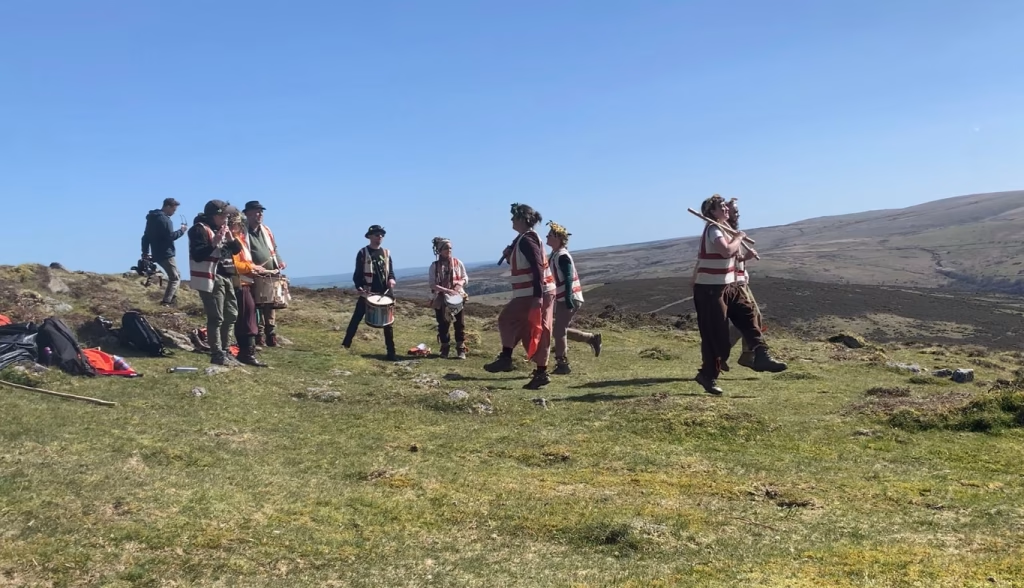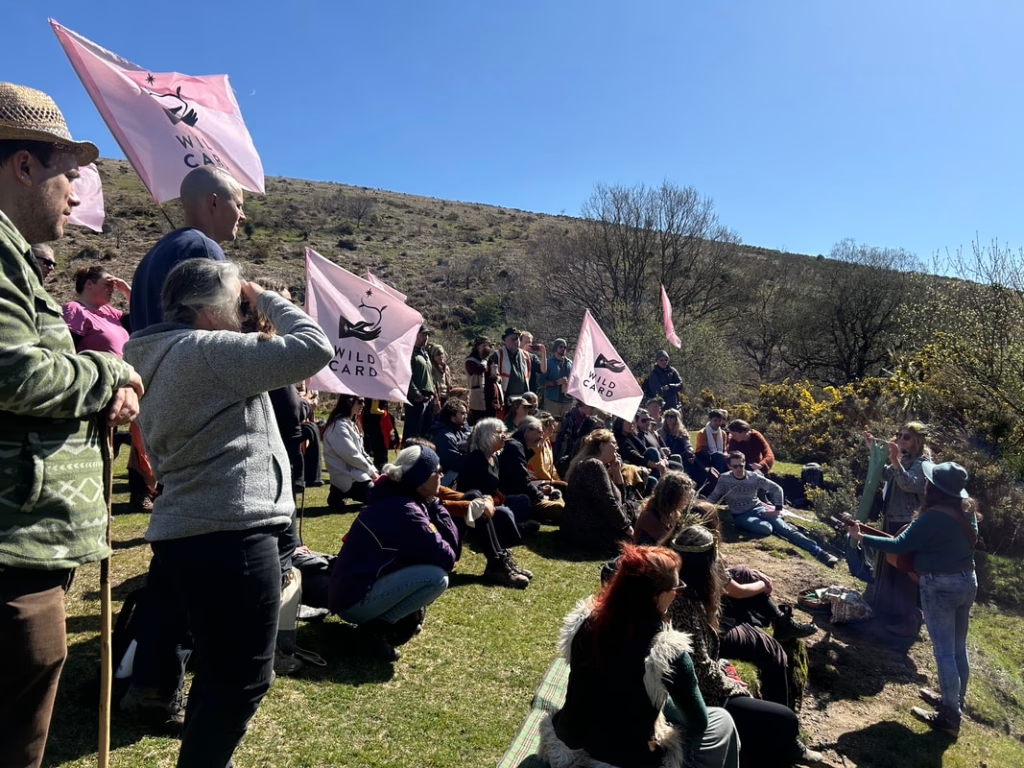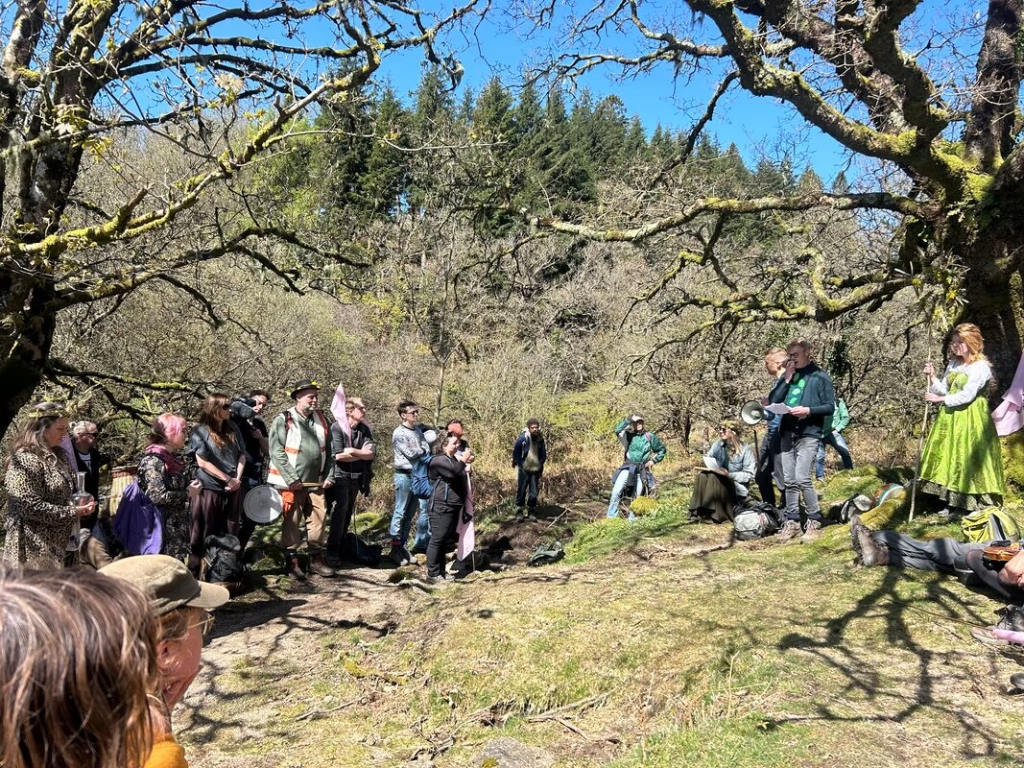The people’s perambulation on Dartmoor

At the end of April, we embarked on the People’s Perambulation, following in the footsteps of twelve mediaeval knights, centuries before us. In 1240, King Henry III ordered the knights to walk the border of the Royal Forest of Dartmoor, marking its boundary to exclude and dominate the peasants of the area. The Forest of Dartmoor is now a common, and the complex web of commoners rights, tenant rights and landowner rights can often exclude people, much as in the thirteenth century.
With this in mind, we wanted to walk a section of this route and think about what the commons mean to us today, and what they could mean to us in the future. Looking beyond the legal definition of a ‘common’ – a piece of land registered under the 1965 Commons Registration Act, or a ‘commoner’ – someone with legally registered rights to a piece of common land, to what are the things we truly should and could hold in common. Our rivers, our seas, our woodlands, our trees, our moors, our night sky, all of these things belong to all of us.
After a great deal of work from the team and Dartmoor locals, we gathered with a festive atmosphere, musicians carrying large cases, the morris dancers daubing mossy green paint on their faces. Flags fluttered in the light breeze as beautiful headdresses and a staff to guide and hold the day, made by Ruth of the Lost Giants, made their way out onto heads and into hands. The weather up until the beginning of the week had been incredibly wet, seeing huge amounts of rainfall. With our route running alongside the East Dart river and traversing some potentially boggy ground, we had been blessed with a beautifully sunny week, with the Saturday being the best day of all.
So it was under bright sunshine and a clear blue sky that we set off, winding our way past the strangely discordant peacock cries and invasive rhododendron bushes until we came alongside the river. Its gentle rushing music drew us along until we reached a wide grassy bend, with gentle slopes down into the river. This is where we had our first stop. The incredible Holly Ebony first read inspiring and thought-provoking words from Hannah Pearson, the head of the Friends of the Dart, whose tireless work has created a community around the river, fighting for it against pollution and misuse. She then led us in singing to the river, the gathered voices weaving with the rush of the river itself. Lisa Schneidau, a wonderful storyteller and keeper of folklore told us the tale of Tamara, how the rivers Tamar, Tavy and Tor all began on Dartmoor, with a dance from MAYDAY morris to the river goddess. Everyone then came down to the water’s edge and was sprinkled with river water, fresh droplets cool and refreshing under the surprisingly powerful sun.

Next, Lisa Rowe and Christopher Dance, two wonderful fiddle musicians led us down to the temperate rainforest, people laughing and talking as we wound our way down and through the gateway created by a sycamore and an oak, branches reaching out together, filigree shadows dappling us, giving respite from the sun. There we heard from Adam Cormac from the Woodland Trust, who told us about the other charter, the forgotten charter, the Charter of the Forest that came two years after the Magna Carta, where peasant’s rights were enshrined, access and connection with nature were woven throughout, and was broadcast from churches multiple times a year. This was only repealed in 1974 by a Conservative government. The Woodland Trust has written their own, new Charter for Trees, Woods and People, encapsulating the wondrous connection that humans and trees have. Then Ash Brown of Ecosystem Restoration Communities spoke about communities that are linked all over the world, working to live in harmony with and boost nature wherever they are. Ash and Holly then both led us in songs while we gave water from the river to the roots of the magnificent trees that had sheltered us as we connected with our ancient woodlands.
We walked on, until we reached the gate that would take us out onto the road and up to the tor. We sat together and ate and drank, people meeting each other, sharing stories and basking in the golden-green warmth of the grass, the river running frothily over its granite bed. We sat for quite a while, the walk ahead of us starkly different, out on a paved road, uphill, out onto the moor.
The stepchange was abrupt, tarmac instead of grass beneath our feet, following the course of flailed hedges and stone walls rather than the flowing water. We wound our way up between houses until they fell away, leaving only the open, bare moor around us. Holly Ebony led us in song up the hill as we climbed under the hot sun. Despite the heat and the gradient, we made good time up the hill, and upon reaching the top, waited to gather everyone, before striking off the road and up onto the tor.

Opposite to the tor, on the other side of the road, sat a cross, a war memorial for a young man that died in 1914 in Palestine. With all that Gaza and Palestine is suffering, we gathered together and raised our voices in harmony. Sometimes a respectful silence is called for, but sometimes we are called to use our voices and speak up.
We then climbed up to the tor, first hearing from Lewis Winks from Right to Roam about how our access to the land, to the rivers, to our natural commons, is vital in being able to care for them. What we cannot see, we do not question, and many awful things happen behind fences, walls, barbed wire and no entry signs. Lisa Schneidau then treated us to another story of circular time, of becoming lost in an estate and finding ourselves one with nature, leading us around in mythical time.
MAYDAY Morris then danced for the witch of Vixen Tor and the Oak, our nation’s tree. Voices raised, feet stamped, sticks cracked, hankies waved as something so quintessentially English and of this land was performed in one of England’s most iconic landscapes. Holly and Clarissa Carylon then serenaded us, as we drank ale and ate cake brought up with us. We lounged in the sun as friendships were made, people laughed and we truly felt as though the would we dream of, one where we all have a right and a responsibility to our natural commons, were possible.
Gradually, people drifted off in the late afternoon sunshine, reporting the first cuckoo of the season heard from the slope down back to the start point. It was a powerful day of community, communing with the land and asking what it is that we want for our future, and the future of life all around us. How do we achieve that? Humans, we are animals, we are mammals, we are a part of the natural world, if we choose to be. Rewilding can and should involve humans in the landscape, in a way that promotes life, all over our natural commons. The natural commons belong to all of us, animal, plant and fungus alike.
Our blog posts are written by our core team and guest bloggers. If you have an idea for a blog post please pitch it to us: info@wildcard.land
CAMPAIGNS
ARCHIVES
- December 2025
- November 2025
- October 2025
- September 2025
- August 2025
- July 2025
- June 2025
- May 2025
- April 2025
- March 2025
- February 2025
- December 2024
- November 2024
- October 2024
- September 2024
- August 2024
- July 2024
- June 2024
- March 2024
- February 2024
- January 2024
- December 2023
- November 2023
- August 2023
- July 2023
- May 2023
- February 2023
- January 2023
